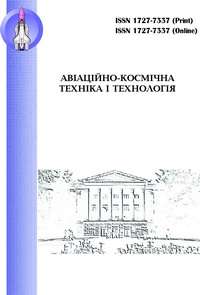Modeling the conditions for obtaining nanostructures during ion-plasma processing taking into account the quantum-mechanical properties of electrode material
Аннотации
The subject matter of the article is the thermophysical and mechanical properties of surface layers of structural materials using a quantum-mechanical approach. The aim of the article is to adjust the parameters of the heat conductivity and thermoelasticity problem, considering all possible external and internal thermal effects and the quantum-mechanical description of the material structure, for electrodes in vacuum-arc nanostructuring.
The task to be solved is to perform calculations using the developed model for a copper cathode considering the energy spent on the formation of nanoparticles during ion-plasma processing with oxygen ions. The methods used are methods for solving nonlinear problems. The following results were obtained. 1. The nature of the dependencies of the maximum temperature, the expected volume of nanostructures, and the maximum depth of their formation on the energy of oxygen ions with charges z = 1 and z = 2 matches previously known dependencies obtained by the classical model, but under quantum-mechanical consideration, the maximum temperature values increase by 15%, the volume of the nanocluster increases by 50%, and the maximum depth
of its occurrence increases by 1.5 times. 2. When selecting the parameters of ion-plasma processing for obtaining nanostructures with ion energies 100...500 eV, the previously proposed model with general thermophysical and mechanical properties of structural materials can be used. 3. For technologies with ion energies in the range of 103...2∙103 eV, the previously proposed model can be used but with quantum-mechanical effects of
structural materials considered. 4) For technologies with ion energies above 104 eV, calculations should be performed using both approaches (the classical approach and the approach considering the quantummechanical properties of structural materials), and after comparison, the variant whose calculation results are closest to the experimental results should be used. Conclusions. The proposed theoretical model using the
thermophysical, mechanical, and quantum-mechanical properties of structural materials can be used to adjust the technological parameters of ion-plasma processing to assess the formation of nanostructures in protective and strengthening coatings. Предметом вивчення в статті є теплофізичні та механічні характеристики поверхневих шарів конструкційних матеріалів з використанням квантово-механічного підходу. Метою статті є корекція параметрів задачі теплопровідності й термопружності, враховуючи всі можливі зовнішні та внутрішні теплові впливи та
квантово-механічний опис будови матеріалу, для електродів при вакуумно-дуговому отриманні наноструктур. Завдання: провести розрахунки за розробленою моделлю для мідного катоду з урахуванням енергії, витраченої на утворення наночасток при іонно-плазмовій обробці іонами кисню. Використовуваними методами є методи розв’язання нелінійних задач. Отримані наступні результати. 1. Характер залежностей максимальної температури, очікуваного об’єму наноструктур і максимальної глибини їх формування від енергії іонів кисню з зарядами z=1 та z=2 збігається з раніше відомими залежностями, отриманими за класичною моделлю, але при квантово-механічному розгляді значення максимальної температури зростають на 15%, об’єм нанокластера зростає на 50%, а максимальна глибина його залягання збільшується у 1.5 рази. 2. При виборі параметрів іонно-плазмової обробки для отримання наноструктур при технологіях з енергіями іонів 100...500 еВ потрібно користуватися раніше запропонованою моделлю з загальними теплофізичними та механічними характеристиками конструкційних матеріалів. 3. При технологіях з енергіями іонів у діапазоні 103...2∙103 еВ можна користуватись раніше запропонованою моделлю, але потрібно враховувати квантово-механічні характеристики конструкційних матеріалів. 4. При технологіях з енергіями іонів вище 104 еВ необхідно проводити розрахунки за двома варіантами (класичний підхід та підхід з врахуванням квантово-механічних характеристик конструкційних матеріалів) і після порівняння використовувати варіант, результати розрахунків за яким є найближчими до експериментальних результатів. Висновки. Наведену теоретичну модель з використанням теплофізичних, механічних і квантово-механічних характеристик конструкційних матеріалів можна використовувати для корегування технологічних параметрів іонно-плазмової обробки з метою оцінки отримання наноструктур в захисних та зміцнюючих покриттях.

